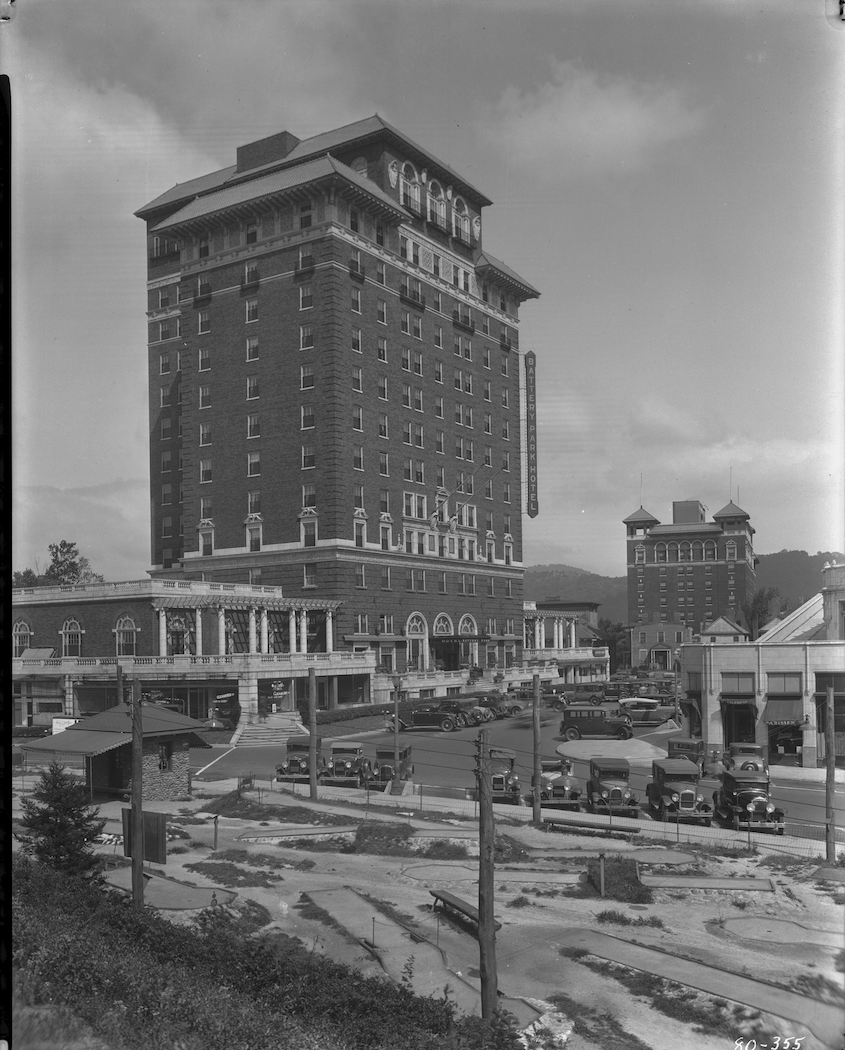Author’s note: This week’s Archives takes place during segregation in the Jim Crow South. Therefore, African Americans and other people of color faced restrictions related to the social pleasures discussed here.
At the onset of the Great Depression, as banks closed and the economy crashed, Ashevillians took to the greens with clubs in hand, joining countless Americans to partake in the latest national craze — miniature golf. Throughout the spring and summer of 1930, several courses opened in the city.
The Happy Hollow, located on the corner of Hillside and Charlotte streets, launched on March 30. A month later, the Original Tom Thumb Miniature Golf Course began its operations across the street from the Battery Park Hotel. Soon thereafter, and just a few blocks south, the regrettably named Midget Country Club opened on Battery Park Avenue.
During this time, neighboring towns, including Marion, Marshall, Montreat, Tryon, Waynesville and Black Mountain, also celebrated the openings of their own 18-hole attractions. In the Aug. 26, 1930, edition of The Asheville Citizen, columnist “Old Hurrygraph” wrote:
“Miniature golf is all the go in Black Mountain, and like death, hath all ages for its own. ‘I hope you will advocate and encourage this sport,’ said a citizen to me today, looking at the links filled with boys and girls and men and women. ‘It is a clean, healthy and enjoyable exercise for young and old, and a meeting place for friends and making friends. It is a great deal better for young girls to be thus engaged than so much riding in automobiles, and parking along the road sides,’ said he. There’s good, sound philosophy in this.”
By the fall, speculation began over how long the craze would last. One Associated Press article featured in The Asheville Citizen compared the miniature golf phenomenon in the United States to a chess-obsessed village in Stroebeck, Germany, where devotion to the game spanned three centuries and counting. Could the same hold true of putt-putt in Western North Carolina?
Meanwhile, other articles tried pinpointing miniature golf’s origin, in part by debunking fictitious claims — including one popular narrative that credited Al “Scarface” Capone as the sport’s creator.
The Sunday Citizen ran a particularly illuminating piece in its Oct. 19, 1930, edition. The paper asserted that a Tom Baber of Pinehurst deserved credit as putt-putt’s originator, not Capone! “Play on this Lilliputian course was known to have begun as early as 1916, some years before the popularity of the sport became so widespread,” the paper wrote.
In the same piece, Garnett Cartner of Lookout Mountain, Ga., was noted as having started the first commercial miniature golf course, Fairyland Court, in 1928.
The story went on to report that the United States had an estimated 25,000 putt-putt courses in operation, 13 of which were in Asheville. (Subsequent reporting put the total local number at nine.) “Some have followed the tendency to install novel contraptions as hazards, but most of the [local] operators have insisted on ‘straight’ golf and declare that they intend to keep their greens for ‘golfers’ instead of those seeking ‘carnival’ fun,” the article concluded.
By 1932, however, the citywide (and national) craze landed in the rough. The new courses, which “flourished in Asheville two years ago when the ‘fad’ was at its height,” were no longer in operation, The Asheville Citizen reported on May 13. Some of the sites had been “junked,” the article continued, “overgrown with grass and weeds.”
And yet like all great sports stories, putt-putt made a comeback.
“Miniature golf, the game that set the country agog several years back but which subsequently waned in popularity to such an extent that all courses here were closed two years ago, again is showing life,” The Sunday Citizen reported on July 8, 1934.
“Dead and buried, it refused to stay down,” the paper added, noting the reopening of the former Original Tom Thumb, located near the Battery Park Hotel.
According to local historian Terry Taylor, the Original Tom Thumb remained operational throughout much of the 1940s (albeit with a few name changes). But in 1947, the Bell South building (today’s AT&T) was erected at the location. Despite the new construction, the miniature golf course remained listed in the city directory until 1951.
Editor’s note: Peculiarities of spelling and punctuation are preserved from the original documents.




Fun article, read right on par with others. Glad you included Montreat’s. It was located on the left of Assembly Inn as you face the Inn with your back to Lake Susan. The golf course “Club House” still stands, a tiny stone house .
Montreat also once had a 5 hole (?) regulation course near the arched stone gate… Circa 1910s …